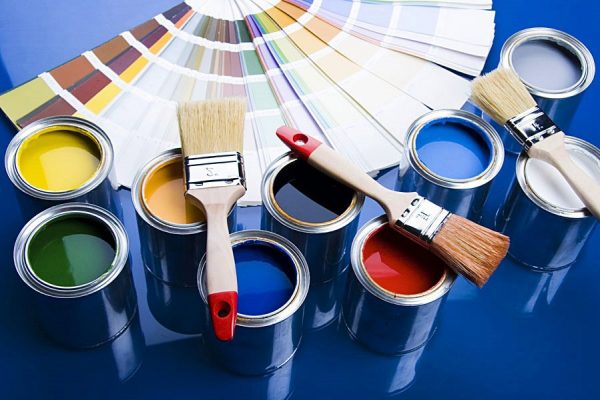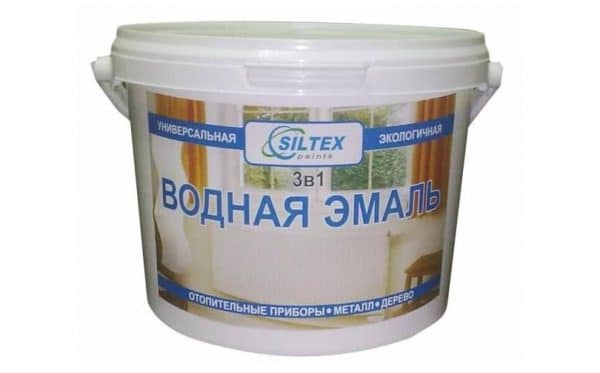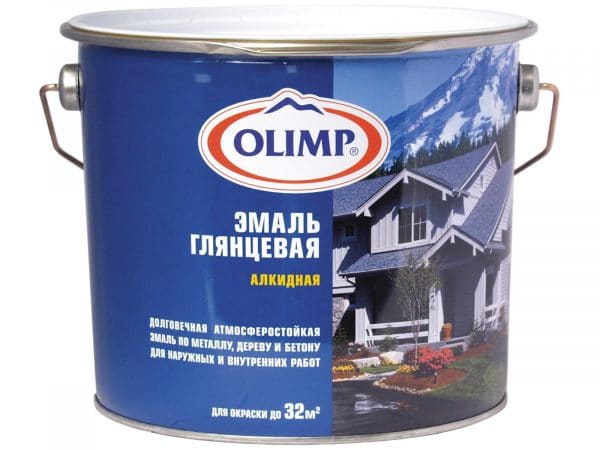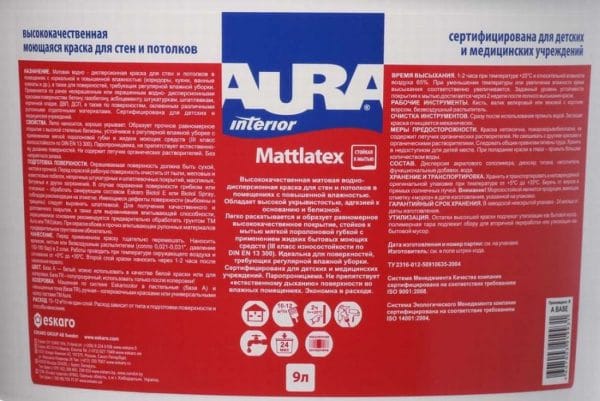Any repair, whether overhaul or cosmetic, requires the use of finishing materials with which the interior is updated, and the work itself becomes easier. Many types of coatings emit strong odors and contain chemicals that affect sensitive people.
- What paint consists of
- How to find safe paint for your walls yourself
- Rule one: every little thing is important when choosing paint for walls
- Rule Two: Examine Available Information
- Rule three: please show permits for paint

It is not always possible to move to another room for the duration of the painting, even if small children or family members prone to allergies live in the house. Modern manufacturers care about the health of consumers and use the latest technology in the manufacture of products to minimize danger. Finding safe finishing material is not difficult if you know the selection rules and carefully read the information about the content and the manufacturer.
to contents ↑What paint consists of
The characteristic odor emitted by the product indicates the presence of a solvent in its structure. Most of this substance is in universal resistant varnishes and low-quality enamels based on alkyd resin, as well as in cheap oil paints from little-known manufacturers. The use of these materials for interior decoration and the direct inhalation of pungent odors has a direct negative effect on the well-being of others.
Today, many companies pay attention to increased consumer safety and are developing water-based paints. Therefore, when choosing from a huge number of paints and varnishes on the shelves of a building market, it is better to dwell on a product of well-known brands that does not contain volatile substances.
The composition of modern paintwork most often includes 4 main components:
- pigment;
- solvent;
- astringent component;
- all kinds of additives.
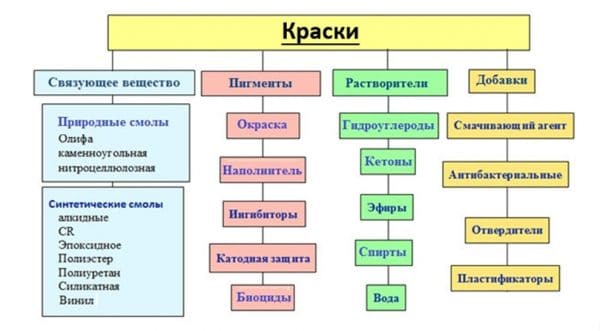
Dyes are used to give the desired color cast. Solvents are necessary to keep the finishing materials in liquid form. Binders provide the formation of a coating film on a painted surface. The main risk is solvents and additives. A pigment can only be harmful if it contains lead and other metallic impurities.
The composition of solvents and additives often includes toxic components and unstable organic compounds, characterized by a pungent odor, harmful to health by inhalation. Alkyd paints contain mineral alcohols (toluene, xylene), which, when ingested, have a toxic effect. Negatively affect the health and other types of chemical solvents:
- with a slight concentration, this is expressed in irritation;
- with a sufficient amount of chemicals a person experiences headache, lethargy, lightheadedness.
For this reason, alkyd paints are recommended for use on external surfaces or industrial structures due to their resistance to harsh environmental conditions. And when painting a living space, a water base is used to dissolve the dyes.
Additional benefits of water soluble paints:
- fire and explosion safety;
- durability;
- environmental Safety.
How to find safe paint for your walls yourself
Toxic varnishes and paints are considered obsolete when renovating a house. In most European countries, the law determines the level of environmental safety of paints, and manufacturers for the most part produce high-quality coatings that do not contain toxins. In our country, less than half of all products now produce such funds. Usually this is due to demand, determined by consumer stereotypes and low price bar, because of which there are those who want to risk their health.
The entry of volatile organic compounds into the composition of varnishes and paints in our time in Russia is not regulated by any legal acts. The only document proving product safety is the Certificate of registration at Rospotrebnadzor, where the material is evaluated for the presence of allergens in accordance with the sanitary and epidemiological standards for coatings. The results of the study should be placed on the label, which is one of the essential parameters for recognizing the composition of the paint.
It is possible to draw a conclusion about the reliability of the product after studying the output data on the package, if the instructions indicate that the material dries quickly, is intended for internal use, and it should be diluted and washed with water. So, he is actually harmless.
to contents ↑Rule one: every little thing is important when choosing paint for walls
The main thing where to start the choice of paintwork is to read the information on the package on what basis it is made. When finishing the internal coatings, preference is given to latex and water-based products. Enamels and varnishes with a certificate confirming the quality, based on non-aqueous solvents of well-known manufacturers, are also harmless.
It’s best to get an idea of the purpose of the product indicated on the label:
- If the paint is designed for external work (fences, arbors), do not use it for internal coatings.
- Varnishes and enamels for painting street benches are resistant to natural factors. But in a dwelling, they can exhibit toxic or allergenic properties.
You can also find out all product data on the distributor's website.
to contents ↑Rule Two: Examine Available Information
It is difficult for consumers to navigate in the extensive line of paintwork materials. In order not to be mistaken, you need to carefully read all the information on the label. Typically, the manufacturer indicates the following data on it:
- the product's name;
- the purpose of the material;
- method of use;
- the most important parameters and properties of paintwork materials;
- rules and conditions for storage, transportation and disposal of paint;
- content and weight;
- date of manufacture;
- shelf life;
- information about the manufacturer (contact information).
Careful attention must be paid to the composition of the paint. If for the most part it consists of natural ingredients and contains a minimum of organic solvents, then you can be sure of its safety. The parameters of solvents in the paint are measured in grams per liter and according to the standards of the Customs Union should not exceed 30 g / l.
It is recommended to purchase material in a finished color so that they do not have to be mixed to obtain the desired shade. The paint should be of a uniform consistency and not contain sediment. The seller can advise whether this option is suitable for self-painting.
to contents ↑Important! The presence of a pungent odor indicates the dangerous contents of the paint.
Rule three: please show permits for paint
Product specifications are confirmed by the accompanying documentation for it, which should be with the seller.Its absence or refusal to provide is a sign of poor-quality or falsified goods that are harmful to health. Mandatory securities include:
- confirmation of state registration in Rospotrebnadzor;
- understanding of compliance with the GOST system (only for enamels, drying oils and anti-corrosion primers);
- voluntary certificate of compliance with fire safety conditions;
- data on the existence of an environmental management certificate from the manufacturer.
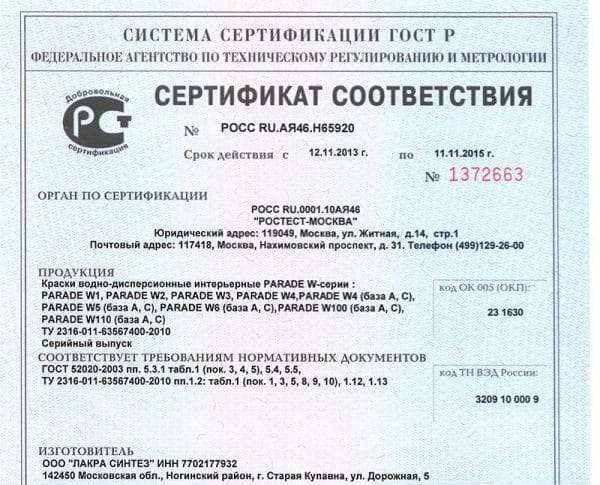
The harmlessness of paint is a conditional concept, not an absolute one. Product reliability is determined by many factors: proper storage, safety precautions during application and disposal. It must be borne in mind that the price of safe formulations cannot be too low.
Interior paints for interior renovation with ease can completely update the design of the home. The main thing is to correctly find safe coatings so that they do not harm your health. Now manufacturers are constantly improving the technology of materials production.

